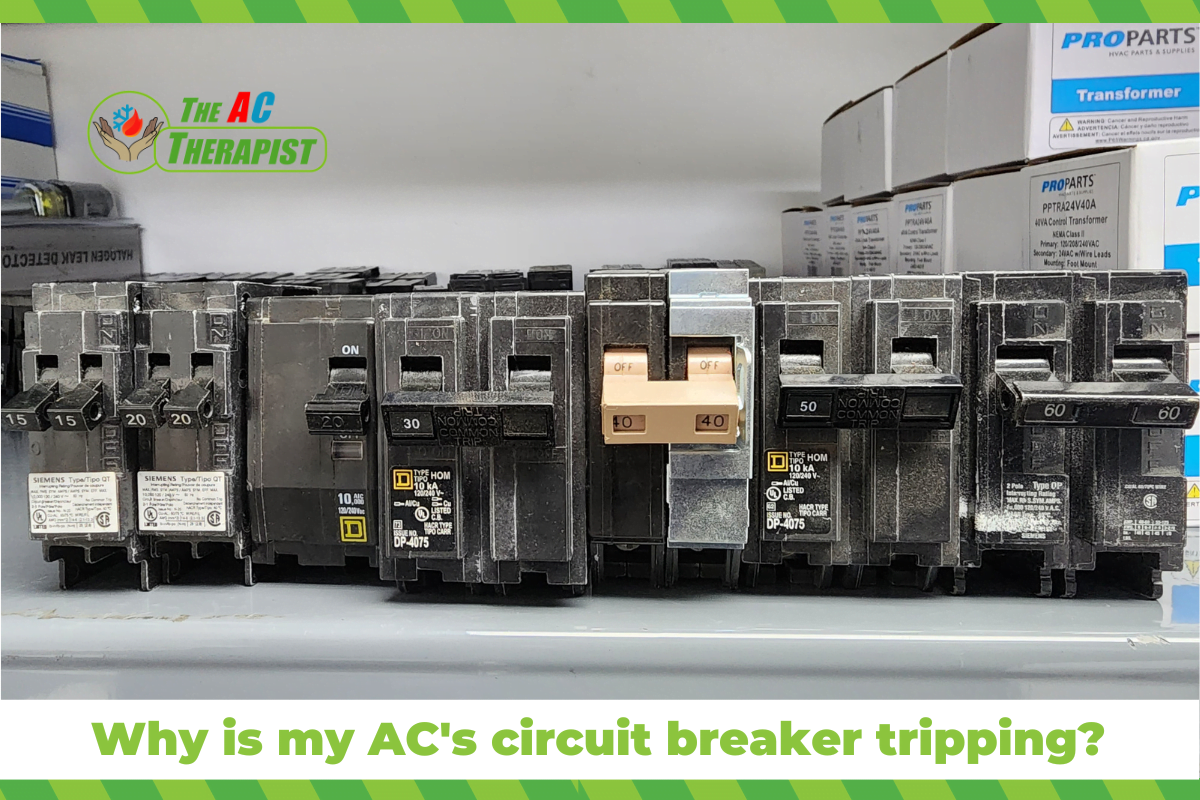Why is my AC’s circuit breaker tripping?
Air conditioning is an essential comfort in many homes and businesses, especially during the hot summer months. But what happens when your AC’s circuit breaker keeps tripping? This can be a frustrating and concerning issue. Below, we’ll delve into the common reasons for this problem and what you can do to fix it.
1. Overloaded Circuit
A circuit breaker’s primary function is to prevent a circuit from overloading. When the electrical demand on a circuit exceeds its capacity, the circuit breaker trips to prevent potential damage or a fire.
- Why It Happens with ACs: Air conditioners draw a significant amount of power, especially when starting up. If other high-power devices are operating on the same circuit, it can lead to overloading. Sometimes if the compressor or fan motors are faulty they can trip the breaker.
- Solution: Ensure that your AC unit is on a dedicated circuit. Consult with a local HVAC contractor like The AC Therapist to make sure your system is correctly installed and properly balanced.
2. Short Circuit
A short circuit occurs when a ‘hot’ wire touches another hot wire or a ‘neutral’ wire within your system. This creates a sudden increase in current, causing the circuit breaker to trip.
- Why It Happens with ACs: Damaged wiring, improper installation, or wear and tear can lead to short circuits in your AC system.
- Solution: Call a professional to inspect and repair any damaged wiring.
3. Ground Fault
A ground fault is a specific type of short circuit where a hot wire touches a grounded portion of your system (like the metal box).
- Why It Happens with ACs: This can happen due to aging, moisture, or damaged insulation.
- Solution: Again, this requires professional inspection and repair.
4. Faulty Circuit Breaker
Sometimes, the issue is not with the AC system itself but with the circuit breaker.
- Why It Happens: Like any other component, circuit breakers can wear out and malfunction.
- Solution: If you suspect this is the case, contact an electrician to replace the circuit breaker.
5. Dirty or Clogged Filters and Coils
Believe it or not, a dirty AC system can cause the circuit breaker to trip.
- Why It Happens with ACs: Clogged filters and coils make the AC work harder, drawing more electricity and potentially overloading the circuit.
- Solution: Regular maintenance like filter changes and coil cleaning can prevent this issue. Consider a Therapy Maintenance Plan from The AC Therapist for regular servicing.
6. Incorrectly Sized AC Unit
An AC unit that’s too big or small for the space it’s cooling can cause problems.
- Why It Happens: An incorrectly sized unit may continuously cycle on and off, leading to undue stress on the system and tripping the circuit breaker.
- Solution: Consult with an HVAC professional to ensure that your AC unit is the right size for your space.
7. Refrigerant Leaks
A refrigerant leak can cause the compressor to overheat, leading to the circuit breaker tripping.
- Why It Happens: Over time, vibrations and wear can lead to leaks in the refrigerant lines.
- Solution: Regular inspections and prompt repair of leaks by a professional can prevent this issue.
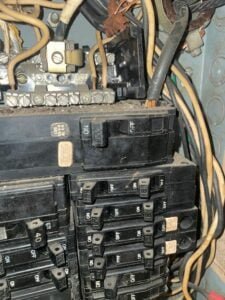
What type of breakers do AC units use?
Air conditioning units typically utilize circuit breakers that are designed to handle the specific electrical requirements of the system. Here’s an overview of the types of breakers used:
1. Double-Pole Breakers (most common in Florida)
Many central AC systems require a 240-volt circuit, which is usually controlled by a double-pole circuit breaker. These breakers are designed to handle the higher power requirements of an AC unit, and they control both the hot wires in the circuit, ensuring that the entire circuit is shut off during an overload or short circuit.
2. Ground Fault Circuit Interrupter (GFCI) Breakers
While not commonly used for central AC units, GFCI breakers are sometimes found in mini-split systems or window units, especially in damp locations. These breakers provide protection against ground faults by rapidly cutting off the power when a leakage is detected.
3. Arc Fault Circuit Interrupter (AFCI) Breakers
These are designed to prevent electrical fires by detecting an unintended electrical arc and disconnecting the power before the arc starts a fire. Though not typically used solely for AC units, they may be part of a home’s overall electrical safety system.
5. Time Delay Breakers
Air conditioners often require a significant surge of power on startup. A time delay breaker allows for a momentary spike in electrical demand (inrush current) without tripping. This type of breaker is particularly useful for systems with compressors and motors that have high startup power requirements.
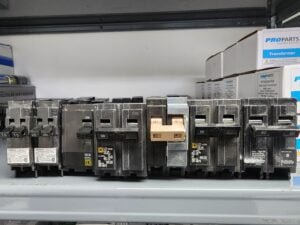
Where is my AC circuit breaker located?
The location of your AC’s circuit breaker can vary depending on the design and layout of your home or commercial building. Here’s where you might find it:
1. Main Electrical Panel
Most often, the AC’s circuit breaker is located inside the main electrical panel or circuit breaker box. This panel is typically a metal box containing various circuit breakers for different parts of the building. It might be found in the following locations:
- Garage: Many homes have the main panel located in the garage.
- Basement: If you have a basement, the panel might be located there.
- Utility Room: Sometimes, the main panel is in a utility or mechanical room.
- Exterior Wall: In some cases, especially in warmer climates like Tampa Bay, the panel may be mounted on an exterior wall of the home or building.
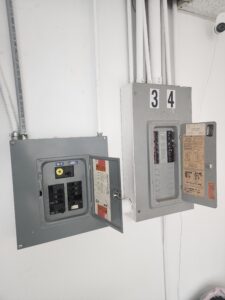
2. Subpanel
In some larger homes or commercial buildings, there may be a subpanel that handles specific areas or appliances, including the air conditioning system. This subpanel would also contain the AC’s circuit breaker.
3. Disconnect Box Near the AC Unit
In addition to the breaker inside the main panel or subpanel, there might be a disconnect box or switch located near the outdoor AC unit. This is a safety feature that allows the power to the AC unit to be shut off without accessing the main panel, usually for maintenance or repair. This box may contain a circuit breaker or simply a pull-out disconnect.
Finding the Breaker
To find the specific breaker for the AC unit:
- Check the Labels: Inside the main panel or subpanel, there should be labels next to each breaker indicating what it controls. Look for the one labeled “AC” or “Air Conditioner.”
- Consult Your Home’s Electrical Diagram: If available, this diagram will show the location of all the breakers, including the one for the AC.
- Ask a Professional: If you are unable to locate the breaker, a local HVAC contractor or electrician, like The AC Therapist in the Tampa Bay area, can help you find it.
Knowing where your AC’s circuit breaker is located is essential for troubleshooting and maintenance. If you’re ever uncertain or uncomfortable locating or handling the breaker, don’t hesitate to reach out to a professional. Safety should always be your top priority, and a qualified technician will have the knowledge and tools needed to handle the situation properly.
How to reset an AC circuit breaker?
Resetting an AC circuit breaker is usually a straightforward task that can be done without professional assistance. However, it’s essential to follow safety guidelines and understand why the breaker tripped in the first place, as resetting a breaker without resolving the underlying issue could lead to more serious problems.
Here’s a step-by-step guide to resetting your AC circuit breaker:
1. Identify the Problem (If Possible)
- Try to determine why the breaker tripped. Was there a power surge? Is there an obvious issue with the AC unit, like strange noises or smells? If the underlying problem is unknown or complex, it might be best to call a professional HVAC contractor like The AC Therapist.
2. Turn Off the AC Unit
- Switch off the thermostat controlling the AC unit.
3. Find the Breaker
- Locate the main electrical panel or subpanel where the AC circuit breaker resides.
- If there is a separate disconnect box near the outdoor AC unit, make sure to check it as well.
4. Identify the Tripped Breaker
- Look for the breaker labeled “AC” or “Air Conditioner.”
- A tripped breaker usually sits in a position between “ON” and “OFF.” It may also show a red or different-colored indicator.
5. Reset the Breaker
- Carefully switch the breaker to the “OFF” position. You might feel some resistance.
- Now, turn it back to the “ON” position.
- If there is a separate disconnect near the AC unit, ensure that it’s also in the “ON” position.
6. Turn the AC Back On
- Switch the thermostat back to its cooling mode and monitor the AC unit to make sure it’s operating correctly.
7. Call a Professional if Needed
- If the breaker trips again or if you notice any unusual behavior from the AC unit, turn everything off and call a professional HVAC contractor like The AC Therapist.
- Continuously resetting the breaker without addressing the underlying issue could lead to damage or a fire.
Safety Precautions
- Do not touch the breaker with wet hands or stand on a wet surface.
- If you feel uncomfortable or uncertain, don’t hesitate to call a professional.
Resetting an AC circuit breaker is generally a simple task, but understanding why it tripped is crucial. If the cause isn’t apparent or the problem recurs, seeking professional help from an HVAC contractor is the safest course of action. Regular maintenance, like those included in the Therapy Maintenance Plans, can prevent many issues that may lead to a tripped breaker, ensuring your system runs smoothly.
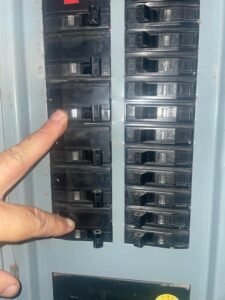
How to change an AC circuit breaker?
Changing an AC circuit breaker is a more complex task that involves working with the electrical system. While it might seem like a doable DIY project for those with some electrical knowledge, it can be risky if you’re not careful. Here’s a general guide to changing an AC circuit breaker, but please note that it’s usually best to call a licensed electrician or a skilled HVAC contractor like The AC Therapist to handle this task.
Safety Precautions
- Turn Off the Main Power: Before doing anything, turn off the main power switch to the entire electrical panel to prevent electrical shock.
- Use Insulated Tools: If you must work on the electrical panel, use insulated tools designed for electrical work.
- Wear Safety Gear: Wear safety glasses, gloves, and other necessary protective gear.
- Avoid Wet Areas: Don’t work on an electrical panel if you’re standing on a wet surface or if your hands are wet.
Steps to Change an AC Circuit Breaker
- Identify the Breaker: Determine the correct circuit breaker that needs replacement. Note the brand, type, and specifications, including the amperage.
- Purchase the Right Replacement: Go to a hardware store and purchase the exact same type of breaker. If you’re unsure, consult with an HVAC professional.
- Turn Off the Main Power: This step is crucial for safety. Make sure to turn off the main power to the entire panel.
- Remove the Panel Cover: Carefully remove the screws holding the cover of the electrical panel and set it aside.
- Remove the Old Breaker: Carefully unclip or unsnap the old breaker from the panel. Disconnect the wire from the terminal by loosening the screw holding it.
- Install the New Breaker: Connect the wire to the terminal of the new breaker and tighten the screw. Then, snap or clip the new breaker into place in the panel.
- Replace the Panel Cover: Put the cover back on the panel and replace the screws.
- Turn the Power Back On: Turn on the main power switch and then turn on the new breaker.
- Test the System: Turn on the AC to make sure everything is working correctly.
While it’s technically possible to change an AC circuit breaker yourself, the potential risks involved in working with electrical systems generally make this a job best left to professionals. An improperly installed breaker can cause electrical shock, fire, or damage to your AC system. By hiring a professional HVAC contractor, you can ensure that the right breaker is used, the installation is done correctly, and your system complies with all relevant codes and regulations. If you’re in the Tampa Bay area, The AC Therapist is equipped to handle these kinds of tasks with the right expertise and care.
How much does it cost to replace your AC circuit breaker?
If you need to replace your AC circuit breaker, The AC Therapist, a local residential and light commercial HVAC contractor in the Tampa Bay area, charges a flat fee of $250 for this service. This cost includes both the breaker itself and the labor to install it, ensuring a professional and seamless replacement.
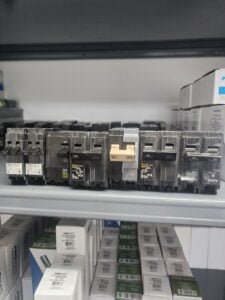
How do you test an AC circuit breaker?
Testing an AC circuit breaker is essential to ensure that it’s functioning properly and protecting your AC system from electrical overloads or shorts. Here’s a general guide on how to test an AC circuit breaker:
Safety Precautions
- Turn off the AC Unit: Before working on the breaker, make sure the AC unit is off.
- Use Insulated Tools: Always use insulated tools designed for working with electrical components.
- Avoid Wet Conditions: Do not attempt to test the breaker with wet hands or while standing on a wet surface.
Testing the AC Circuit Breaker
- Visual Inspection: First, look at the breaker to check for any obvious signs of damage, wear, or corrosion. A damaged breaker will likely need replacement.
- Use a Multimeter: A multimeter is an essential tool for testing the breaker. Set it to the voltage setting appropriate for your electrical system (usually 240V for a standard residential AC breaker).
- Test for Power at the Breaker:
- With the breaker in the “ON” position, place one probe on the terminal screw where the wire is connected, and the other probe on the ground or neutral bar inside the electrical panel.
- The reading should be close to the rated voltage for the breaker (e.g., 240V). If there’s no reading or a significantly lower reading, the breaker may be faulty.
- Test the Circuit:
- Turn off the breaker and disconnect the wire from the terminal screw.
- Turn the breaker back on, and test again between the terminal screw and the ground or neutral bar.
- If there’s no reading, the breaker itself is likely defective.
- Consider Professional Testing: If you’re unsure about the results or if the breaker seems faulty, it’s wise to call a professional HVAC contractor like The AC Therapist or a licensed electrician. They have specialized tools and knowledge to accurately assess the breaker’s condition.
Conclusion: Your Trusted Guide to AC Circuit Breakers
Your AC’s circuit breaker tripping is more than just an inconvenience; it could be a sign of a more severe underlying problem. From overloaded circuits and short circuits to dirty filters and incorrect sizing, several factors can contribute to this issue.
By understanding these common causes, you can take proactive measures to prevent them. Regular maintenance, professional inspections, and choosing the right service plan, like those offered by The AC Therapist in the Tampa Bay area, can keep your AC running smoothly and your home comfortable.
If you’re experiencing this issue, don’t hesitate to reach out to a professional HVAC contractor to diagnose and fix the problem. Regular maintenance, such as those provided in the Therapy Maintenance Plans, can also help in preventing such issues from arising in the first place. Remember, proper care and prompt attention to problems can prolong the life of your AC system and keep you cool all summer long.

